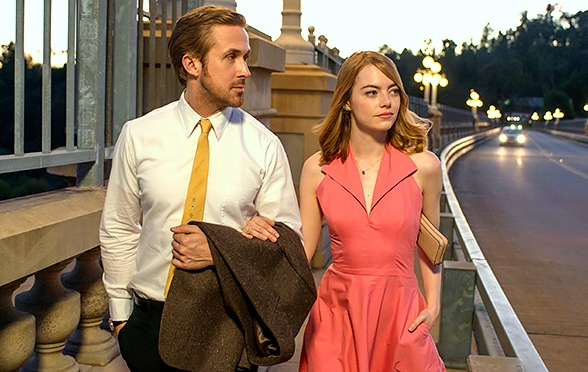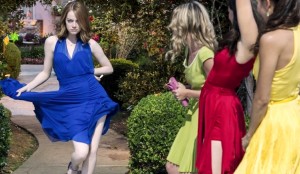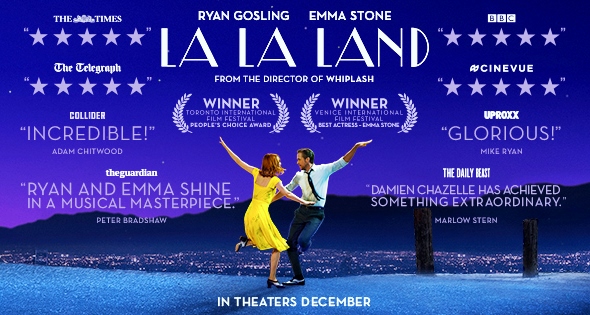
Old-fashioned heaven meets the contemporary. La La Land is without a doubt a classic movie musical, one that enchants breezily, and yet it hits me personally in quite a number of special ways. First, I realized, there are countless fine movie musicals that have been made over the history of film. But very few splendid ones that last from first scene to last. I don’t usually go ga-ga enough to want to see a musical, enshrined by classic status or Oscar gold, a second time. You’ll never catch me watching “Swing Time” or “My Fair Lady” or “Gigi” or “West Side Story” more than once. There was a time I had to see “Singin’ in the Rain” every year, and now it’s the same case with “The Band Wagon” with Fred Astaire and Cyd Charisse, it’s like a favorite tune stuck on my inner repeat button. I have just seen it once, but I am to be hooked on “La La Land” in that same addictive way. Even if I don’t see it again soon, it’s one that I’ll be thinking about in reverie.
Damien Chazelle, the director – whose “Whiplash” and now “La La Land” instantly makes him to me one of my favorite filmmakers, just like that – opens his film with a freeway musical number “Another Day of Sun,” and just when I thought it’s filmed too gritty, too, ahem, smoggy-looking, he finds a way to keep moving the camera, keeps having more actors step out of their cars to dance, keeps finding ways to capitalize on the notes of the song that’s being sung… I was being dazzled by its synchronicity, and it’s sudden charm, and I couldn’t see ahead to see what was going to pop out at me next.
The summer dresses with pop colors, the leaves of auburn and chestnut brown on the ground, the very specifically chosen palm trees, the twinkling lights present just because any place should have twinkling lights. Chazelle picks these things out meticulously for a reason, and that’s to give us a romanticized idealized Los Angeles. Not the smoggy one, but the heavenly one. There are scenes lit with a purplish haze, just to make it look that much better. I loved “Midnight in Paris” the same way, how Woody Allen gave us a romanticized Paris where the lights luster perfectly, not the congested and gaudy Paris that has become a reality.
Ryan Gosling and Emma Stone are the perfect actors for this Los Angeles fantasia, and it’s true, that if you told me about this project a year ago then maybe I would have doubts with them. Instead I’m starstruck. I’m personally affected by Gosling’s retro-hipster jazz musician character, because I think he’s the guy I wished I had turned out to be. Like Sebastian, I can be geek passionate about my art, I want to dance or tell my own idiosyncratic soliloquy, I want to get impassioned on retro art and culture. Gosling has a way though that he can be geeky but cool, he can say something totally self-serving and be handsome about it, he can bring others together with an elbow nudge. He goes in for the kiss at the right time. I wanted to be this guy!
As for Emma Stone, I never totally understood her stardom except maybe for the analysis that it was just luck. The daffiness, the big eyes headlining an asymmetrical face, the lack of swan-like height… but oh my, she’s perfect here and I wanted no one else! There’s an honest pining for perfection with Stone and her aspiring actress character Mia, the sincerity is infectious, and gosh darn it if I didn’t admit her dancing was so natural its hypnotic.
 Stone has a classic first rude encounter with Gosling, but they meet at a party later where he’s performing 80’s rock tunes at piano bass, and things lift up soon after he’s done his Gene Kelly routine and she’s done her Cyd Charisse routine (it has one of those dance numbers that is beloved instantaneously for movie lovers). This is an ups-and-downs romance that soars very quickly to the top of the ceiling, as conveyed in a magical dance sequence where they literally float at Griffith Observatory, and down in the pits because their careers pull them different directions. His dream is to open a jazz club, her dream is to make it as a famous actress.
Stone has a classic first rude encounter with Gosling, but they meet at a party later where he’s performing 80’s rock tunes at piano bass, and things lift up soon after he’s done his Gene Kelly routine and she’s done her Cyd Charisse routine (it has one of those dance numbers that is beloved instantaneously for movie lovers). This is an ups-and-downs romance that soars very quickly to the top of the ceiling, as conveyed in a magical dance sequence where they literally float at Griffith Observatory, and down in the pits because their careers pull them different directions. His dream is to open a jazz club, her dream is to make it as a famous actress.
God bless Chazelle as both a director and a writer for being so sparing and precise. Chazelle draws from the 1964 French film “The Umbrellas of Cherbourg” where every line, even the mundane ones, were sung practically in a low baritone. We get everyday dialogue here, but the European surreal lighting style is often imitated. But the love story concept is what’s crucially borrowed, in how cosmic forces can drive people together and then apart (like the moods of the weather). “Umbrellas” drove you into the melancholy pits, its’ design purpose, but in that design you felt aloof and disaffected. I have seen “Umbrellas” twice, and I saw it a second time years later only because I really couldn’t remember how it ended. I can see why I had forgotten – it kind of fizzles off.
“La La Land” goes into the melancholy pits, too, and for a little while longer than I would have preferred! But Chazelle does it with tact and precision, and he also does it because his film ends up going to a place very deep. He makes your heart ache and swoon at the same time, and unlike “Cherbourg,” it’s an awesome and radical conclusion. I was emotionally elevated.
Chazelle is also drawing upon the forgotten Scorsese musical “New York, New York” (1977) that was also about two artists that are driven apart by their goals, and Sebastian and Mia have a pivotal spat and a miscue of one showing up late to their partner’s opening night live performance. The Scorsese film, so obviously an influential plot design, had beautiful moments as well as painfully truthful moments. But at just under three hours it was a rambling mess. Scorsese admitted he made the mistake of letting his actors improvise during the domestic fight scenes, and that later, there was no way in the editing room to cut it down.
The control that Chazelle employs with “La La Land” is gallant in comparison! I also remember that the kind of entertainment industry parties I once went to sounded and felt much like the ones here – I remember the snobbery of producers and their pronouncements of would-be important projects and the starlets who all promised they were going to be famous next month based on the flimsy little part they were going to film. “La La Land” is a romantic film, as I promised, but it gets these little side details right, and they are more timelessly true than just satiric. But the film doesn’t wallow in coarseness. “La La Land” has beautiful composure and flow.
Effortlessly, Chazelle steers us through one hard luck story and then the other euphoric one that doesn’t quite happen – but really he just given us two movies, and the result is bittersweet but with an afterglow. As a whole, “La La Land” is this beautiful hallucination where you don’t ever want to go home, you want to sink in and live inside the movie.
The peerless melodies are by Justin Hurwitz (“Another Day in Sun,” “Audition,” “City of Stars,” all those and more, it’s a complete album). John Legend, Rosemarie DeWitt and J.K. Simmons appear.
126 Minutes. Rated PG-13.
MUSICAL / INSPIRATIONAL / MASTERPIECE VIEWING
Film Cousins: “Singin’ in the Rain” (1952); “The Umbrellas of Cherbourg” (1964, France); “New York, New York” (1977); “Everyone Says I Love You” (1996).





